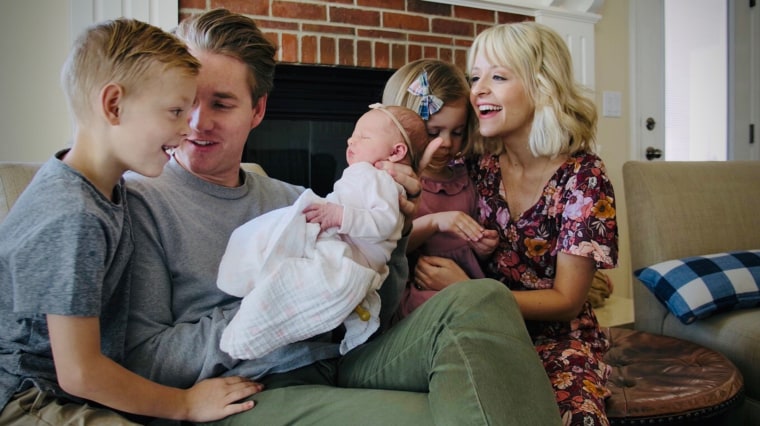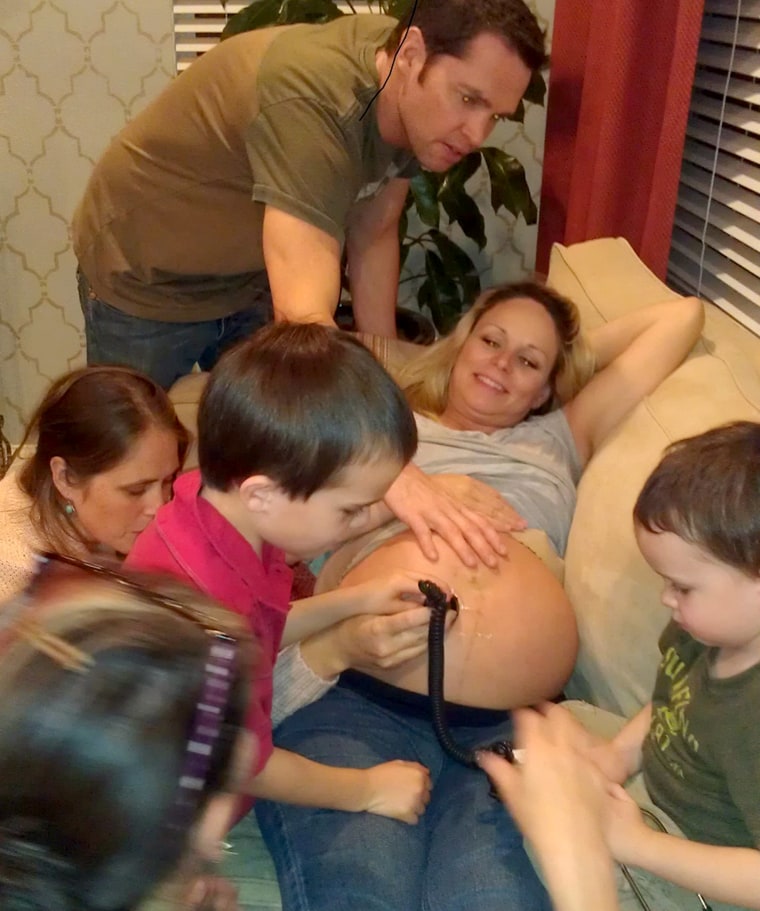When the COVID-19 pandemic changed hospital visitor policies, Kelsey Nixon started reconsidering her birth plan. She has had three children in a hospital setting, but now she was considering a home birth.
“Never in a million years did we think we would jump into a home birth,” Nixon, 35, told TODAY.

Nixon had a gestational surrogate, Megan Blackhurst, 26, who had successful home births in the past. That helped Nixon and her husband feel comfortable. Yet, when Blackhurst was 41 weeks pregnant and nowhere closer to delivering, they decided a hospital birth would be safest.
"Both of us independently kind of said to the other 'I don't know do you think we should really revisit our plan to be in the hospital?'" Nixon explained.
On April 11, 2020 Blackhurst delivered a baby girl, Penelope, at a hospital.
"We had an incredible experience," Nixon said. "I was able to ... catch the baby and Megan did beautifully."
Home births are rare in the U.S. with about 35,000 births occurring in the home. The American College of Obstetricians and Gynecologists (ACOG) doesn't have any updated data indicating if the number of home births has increased during the pandemic. However, it issued an updated committee opinion:
Although recognizing that many patients are experiencing new concerns because of the COVID-19 pandemic, hospitals and accredited birth centers remain the safest settings for birth, even during COVID-19 and especially for individuals with suspected or confirmed COVID-19. Patients concerned that delivering in a hospital or accredited birth center setting will increase their risk of exposure to COVID-19 should be assured that hospitals and accredited birth centers continue to be safe with strict infection control procedures
If you're thinking about having a home birth, there are a few things to consider.
How many people are having home births in the U.S.?
Approximately 1% of U.S. parents opt to have babies at home or have unplanned births at home. While the numbers of home births are slowly increasing, rates of home births in the U.S. still don’t compare to those in other countries. In the Netherlands, for example, about 17% of births occur at home.
“Since 2008, there has been a small increase in home births,” Shadman Habibi, director of the nurse-midwives program at UCLA Medical Center, Santa Monica, told TODAY. “It is not an established way of having a baby.”
There are several reasons why home births aren’t as popular in the U.S.: Research on the safety of home births is limited and home delivery isn’t well integrated into the U.S. health care system. Many insurance companies don’t cover it and families must pay out of pocket.
But there are advocates: For many women, home birth feels like the natural choice. A home birth provides a sense of comfort they don't experience in a hospital setting.

“I had a lot of fear and my midwife helped me to work through that,” Dawnielle Seldon, 43, of southern California, who had two home births, told TODAY. “There was a lot of caring, compassion, a lot of explaining every tiny decision, and allowing me to fully make those decisions and not trying to sway me.”
The research on home births
While there are few studies about home births — it's hard to design a randomized, controlled study — there are some observational studies describing outcomes for mom and baby.
Based on the existing research, ACOG stated, in a position paper published in April 2017, that home births are associated with a “twofold increase in perinatal death” and recommends doctors advise women that home births can be dangerous.
Dr. Richard Beigi suspects that little-to-no monitoring of babies during home births might lead to worsened outcomes.
“If you don’t look, you don’t find a problem and you don’t intervene,” said Beigi, chief medical officer at University of Pittsburgh Medical Center, Magee-Womens Hospital. “It doesn’t mean every intervention we do produces less baby risk. However, we are obviously reducing some risk with a portion of the interventions we perform in the hospital.”
States where home birth is more integrated in the health care system (where midwives work closely with doctors at hospitals), such as Washington or New Mexico have higher rates of home births, noted Michelle Palmer, an assistant clinical professor at the University of Rhode Island and fellow of the American College of Nurse-Midwives (ACNM). That’s because women know it’s an option.
Palmer stressed that midwives adhere to fetal monitoring standards provided by the ACNM, and conduct "constant risk assessment during pregnancy, labor, birth and postpartum."
"For the essentially well woman experiencing a healthy pregnancy, intrapartum, postpartum, and newborn course, childbirth with qualified providers can be accomplished safely in all birth settings, including home, birth center, and hospital," ACNM noted in a position statement on planned home birth.
What to know when considering home birth
While experts agree that women should give birth where they feel most comfortable, it's important to know that some women are not good candidates for a home birth. Younger moms who have no complications and are healthy can generally have a home birth safely.
Doctors, ACOG and midwives shared this list of health issues that would make a home birth a concerning choice:
- High blood pressure
- Gestational diabetes
- Advanced maternal age
- Labor before 37 weeks
- Placenta previa, where the placenta lies before the baby so it would be delivered first
- Previous cesarean section
- Abnormal vaginal bleeding
- Active genital herpes
- Inadequate growth of baby
- Breach baby
- Prolapsed umbilical cord
While ACOG does not provide clear guidelines on what age is too old for a home birth, a spokesperson noted that risks for complications, such as preeclampsia, increase at age 35.
Midwives evaluate women throughout their pregnancy to make sure they are healthy enough for home birth.
“We are going to look really carefully. Are they in the best place in their life to keep them healthy and safe?” Palmer said.
For Nixon and Blackhurst, a late arriving baby felt too risky for a home birth. While the labor and delivery went well, Blackhurst experienced a "pretty severe postpartum hemorrhage." She received quick treatment for from doctors.
"We felt grateful we were in the hospital," Nixon said.

When it comes to finding a midwife, experts recommend looking for either a certified nurse midwife, certified midwife or certified professional midwife. This means they are trained and licensed for delivery at home. While having a certification is the first thing to look for, parents-to-be should ask other questions to understand their midwife's approach.
“Ask if they have a collaborative agreement with an obstetrician and what the rate of their (hospital) transfer is; what bad outcomes have happened to them and what have they done to ameliorate the risk,” Habibi said.
How much does a home birth cost?
America's Health Insurance Plans, a national association whose members provide coverage for health care, said in a statement shared with TODAY that many things contribute to cost:
"As far as home births, coverage will depend on a number of factors including: the insurance provider; the plan the mother selects and the provider network within that plan; whether her midwife/doula is included in the network or associated with an in-network provider; and varying state laws regarding midwives."
The ACNM notes that insurance coverage and cost for home births varies by state with some areas on the East and West coasts seeing higher costs, ranging from $6,000 to $10,000. The cost for hospital births varies greatly based on coverage and location, but estimates from 2015 report an average cost of $10,000 for a vaginal delivery and $15,250 for a C-section.
"In most parts of the country it will be more like $3,500 to $6,000," Andrea Christianson, a member of ACNM, told TODAY via email.
Transfers to hospitals should be covered under insurance and shouldn't add to the cost, Christianson explained.
But, again, that varies based on your coverage: Ashley Dunn learned this when her second planned home birth ended as a hospital birth. She previously had a successful home birth, but when laboring at home with her daughter five years ago, the baby's heart rate slowed. Her midwife transferred her to the hospital where Dunn delivered soon after arrival.
"Thankfully, she was OK and she was born fine. If anything, I was very very fortunate," Dunn, 34, of Meredith, New Hampshire, told TODAY.
While Dunn paid about $3,000 for the midwife and home birth, she had to pay about an additional $8,000 for the transfer. At the time, she did not have health insurance.
For others, a lower cost makes their choice to deliver at home all the easier.
Stacy Spensley, 35, of San Diego, California, wanted the compassion of a home birth. But its slightly cheaper price tag also factored into her decision. Her first son was born in a hospital and it cost $3,000 out of pocket. Her second birth, which took place at home, cost $4,000, but the estimated hospital cost was $6,500.
"We had a relatively uneventful hospital birth with our first with zero complications and no need for medical intervention, so we figured that the only things we didn't like about the experience could be avoided if we stayed home," she told TODAY via email.
But most families choose home births because it feels right. Take Dawnielle Seldon, who had one son at a birthing center and her other two sons at home. Both of her midwives offered her what she felt no doctor could.
“Labor was more in my hands and I felt like I was respected,” she said. “It was a completely different relationship.”
This story was originally published in August 2018. It was updated on September 10, 2018, to include statements by the American College of Nurse-Midwives. This story was updated again on May 18, 2020 to include information about the coronavirus pandemic.



